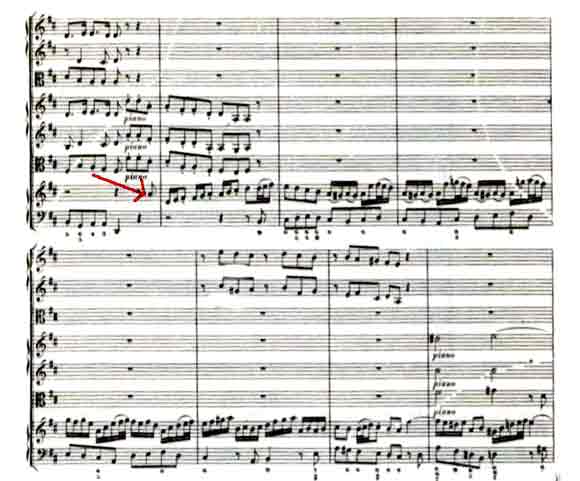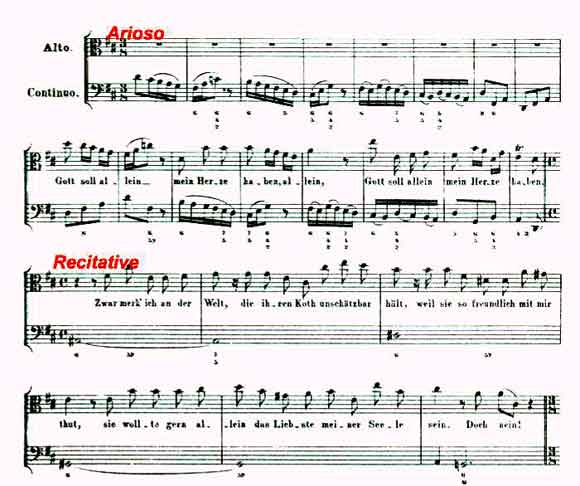Cantata 169 was written in 1726 for the 18th Sunday after Trinity. It is one of only two known cantatas written by Bach for that feast day. This is one of four cantatas written by Bach for solo alto, and, according to Schulenberg, it is the last and best of the four. (Perhaps Bach hones his craft with each subsequent creation?) Cantata 169 is also notable for the use of obbligato organ parts, something which also occurs in Cantata 35 and 49, written earlier that year in Leipzig. In Cantata 169, the obbligato parts were taken from the E Major Concerto (BWV 1053) by Bach. Was Bach experimenting with the obbligato organ, or was there something special going on with the organ or organist at the time? Bach was a superb organist – was this special organ part written for himself?
The overture, in fact, also appears in Cantata 49 and the E Major Concerto (BWV 1053), both of which are mentioned above. (Given the number of works Bach had to produce in Leipzig, it’s surprising that he didn’t recycle more often!) The cantata begins in unusual fashion, with the violin I section of the orchestra alone – no continuo, no other parts at all. This is a purely instrumental movement in a da capo form, with the middle section turning to b minor, the relative minor key. Although the tempo and meter remain constant through the three sections of the form, the middle section is initially very different from the first section, with the turn towards minor and the reduced orchestral role. The organ, which is prominent in all sections, takes the lead throughout this middle section, accompanied continuously by the continuo, which performs a constant walking bass line until the approach of the final cadence (at which point we return to D major and the opening section).

The second movement is an arioso for solo alto, accompanied by continuo. It is appropriate as a movement for solo voice, given that the text numerous times mentions “I” – not we. The texture alternates between arioso passages and freer, more sustained secco recitatives. The overall form reminds us of the more modern rondo form, especially with Bach using the same melody in D major in each arioso passage, which is minuet-like in character. Each arioso passage also begins with the text “Gott soll allein mein Herze haben” (God all alone my heart shall master).

Personally, I love the fact that this movement is a simple two-part texture, which alternates between two types of music: it’s a perfect musical representation of a dialogue between the singer and her God.
Following this is a more elaborate aria in three-part texture: solo alto, obbligato organ, and continuo. But the movement is another one recast from the concerto – the solo vocal part is superimposed upon what was another movement of the concerto; as a result, the beautiful alto solo part is often lost in the “busy-ness” of the organ.
This is a da capo aria, with the first (A) section using exclusively text heard in the previous movement: “Gott soll allein mein Herze haben, Ich find in ihm das höchste Gut” – God all alone my heart shall master, I find in Him the highest good. Another connection to the previous movement is the opening motive; compare the rising sixteenth-note passage to the descending sixteenth-note passage which opened the previous movement.

The B section moves to b minor, the relative minor (the same tonal shift occurred in the first movement, the overture, which is also based on the concerto), and introduces new text: “he loves me in the worst of times” – perhaps the minor key reflects the worst of times?
A short secco recitative follows, leading to another aria. The aria which makes up the fifth movement, brings all the instruments of the orchestra (except the oboes) back for the first time since the opening movement. This is another dance-like movement, perhaps a siciliano because of the 12/8 meter, moderately slow tempo and many dotted rhythms. (Schulenberg, in fact, refers to a designation of “siciliano” in the harpsichord version of the concerto. Indeed, this movement can be found as the slow movement of that concerto. Unlike the previous aria, this one never suffers from the soloist being overwhelmed by the organ obbligato. Indeed, the alto soloist is always the focus here, when she is singing. Bach does a nice job of connecting the evils of the flesh (Fleischestriebe) and the world (Welt), rather than heaven, as he writes long melismas on both of these words – the longest melismas in the movement, which makes it easier to make the aural connection between the two. That is, after, the focus of the text here – the sins of the flesh connect us to this world and not to heaven; by allowing such concerns to “die in me” (Stirb in mir), we allow ourselves a greater chance of reaching God in heaven.
After another short recitative, in which the soloist delivers a moral message from the Bible (thou shalt love God and thy neighbor), the cantata concludes with a four-part chorale setting of Luther’s “Nun bitten wir den heiligen Geist”.










































